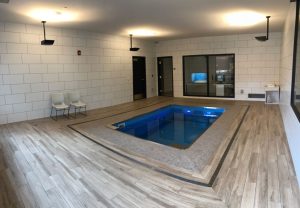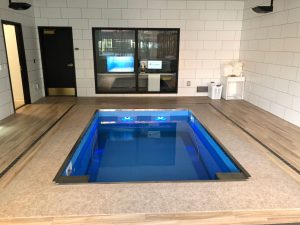Four Lessons from USU’s New Center for Clinical Excellence

“I didn’t apply for the job of dean,” stated Dean Foley. “But sometimes our course in life takes an unanticipated turn. Utah State is a very forward-thinking institution. When I accepted the position of dean, I looked around and thought, ‘I could really do something special here.’”
Since her days as a clinician, Beth has been acutely aware of resource demands—in time, energy and money—facing families of children with disabilities. She saw the families’ need for multiple types of therapy and other medical visits exceed that of almost any other demographic. Beth wondered how all of these services might somehow be combined, with one cohesive plan, empowering families with the best prospect for practical resource utilization.
Construction began in 2016 and the ribbon was cut to open the Sorenson Legacy Foundation Center for Clinical Excellence (CCE) in May of 2018. Some of the programs now housed in the massive but welcoming building have existed at Utah State University for decades, scattered throughout campus. Now these clinics, research labs, and educational programs are lodged under one beautiful location. This provides the setting for a much sought-after interdisciplinary approach to learning, teaching, researching, and care-giving.
Tips For Building A New Clinical Space
Early Collaboration Equals Installation Success.
Because of its clinical offerings and aesthetic appeal, the HydroWorx 2000 therapy pool slated for the project quickly assumed a prominent position near the CCE’s central healing garden.
“Visual access of the HydroWorx pool was important,” stated Joe Jacoby, the project’s lead architect and principle of Jacoby Architecture, Salt Lake City, Utah. “We all wanted people to see this amenity in a beautifully designed space.”
Because of the size and complexity of the pool components, open and frequent communication between structural engineers, contractors and the HydroWorx team from an early date was essential to this successful installation.
Proper Planning and Preparation Prevents Poor Performance.
This saying originated with the British army and many of us grew up hearing it from parent and coaches. USU’s Center for Clinical Excellence reinforces this idea.
After a summer leadership training at Harvard University several years ago where the requirement was to conceive of a worthwhile project and plan out its implementation, the CCE was born.
“When we came home from Harvard,” explained Beth, “I talked to the department heads and asked what they thought about bringing together all of our clinical training programs and our clinical research into one facility and training the students in an interdisciplinary way. We would give them research opportunities with faculty to execute evidence-based practice. Everyone seemed very much on-board.”
Eight department heads, contractors, the state of Utah, USU—all of these entities had their say in how the project took shape. Effective large-group planning meetings were crucial.
“Sometimes with a team that big, the size becomes problematic,” said Jacoby. “These meetings included up to 20 people with everyone solving problems together. When there were problems, we all put on our thinking caps and planned how to move forward.”
The team programed clinical, educational, and research functions that had been in operation in 10 different buildings, some of them for over 40 years, into one building. Getting faculty to work across discipline boundaries and finding ways to foster interdisciplinary collaboration was a battle only won through strong leadership and planning. And the benefits are evident: When USU students are in a hospital setting someday and need to coordinate with other disciplines, they will already have practical experience. The college will be producing job-ready, skilled graduates with practical, hand-on experience, ready to contribute to the job market immediately.
Great Design Can Be a Product of Function.
The Firth of Forth Bridge, an engineering symbol of Scotland, was constructed to carry heavy railcars across the Firth of Forth. Its amazing form came as a product of its function. The Eifel Tower in Paris achieved its airy lattice design to bear heavy wind loads of the Paris Basin. Some of our planet’s greatest structures affirm that, in many cases, form follows function.
Joe Jacoby explained how the form of the CCE took shape.
“After we determined the complex programming for the building, at that point, we pretty much had the design. For example, patron confidentiality necessitated an underground parking lot. Also, we wanted the HydroWorx 2000 pool to be a focal point when not in use, yet private during treatment sessions. And we didn’t want departmental ‘silos.’ Working all these pieces and many, many more into the puzzle was a major challenge.”
Specially treated ceramic tile for the pool deck, layers of distinct moisture barriers for the walls and ceiling, and a well-designed control room all make the pool area within the Dennis Dolny Movement Research Clinic both user-friendly and aesthetically pleasing.
“We were literally within inches of capacity in every direction; north, south, east and west. In the end, the function of the building became the design. And it worked out beautifully.”
A Dream Can Go a Long Way.
Gazing at the CCE Beth shed tears during the ribbon-cutting ceremony, the realization of a long-time dream before her. Her team’s end goals—blessing families and creating an interdisciplinary approach—drove every short and long-range decision during design and construction.
“That building exists because of Beth,” stated Jacoby. “Her leadership in keeping each departments’ individual needs synergetic was really something.”
Thomas Edison said, “Opportunity is missed by most people because it comes dressed in overalls and looks like work.” This team dreamed, collaborated, planned and designed with grit and courage. Those in search of clinical excellence will benefit from USU’s Sorenson Legacy Foundation Center for Clinical Excellence for years to come.
To see the building’s design https://scce.usu.edu/


